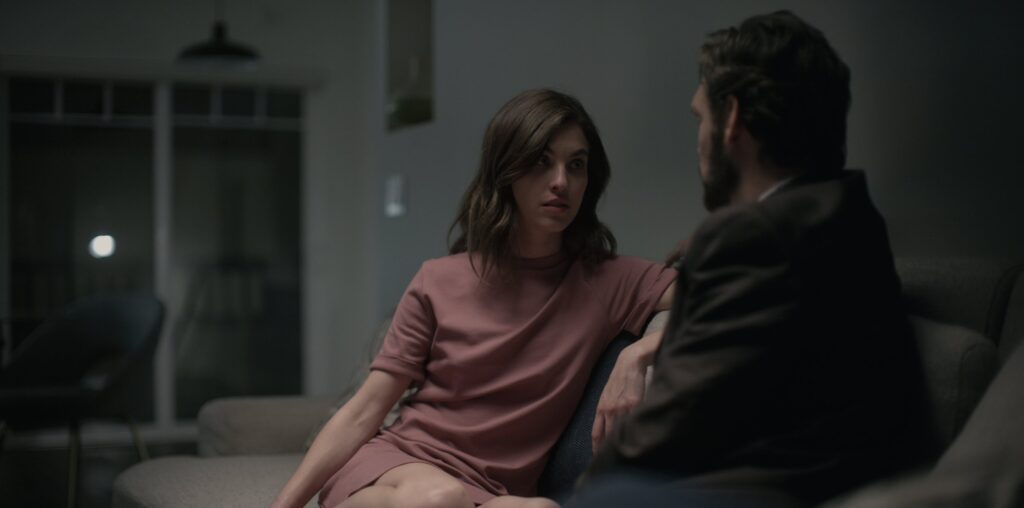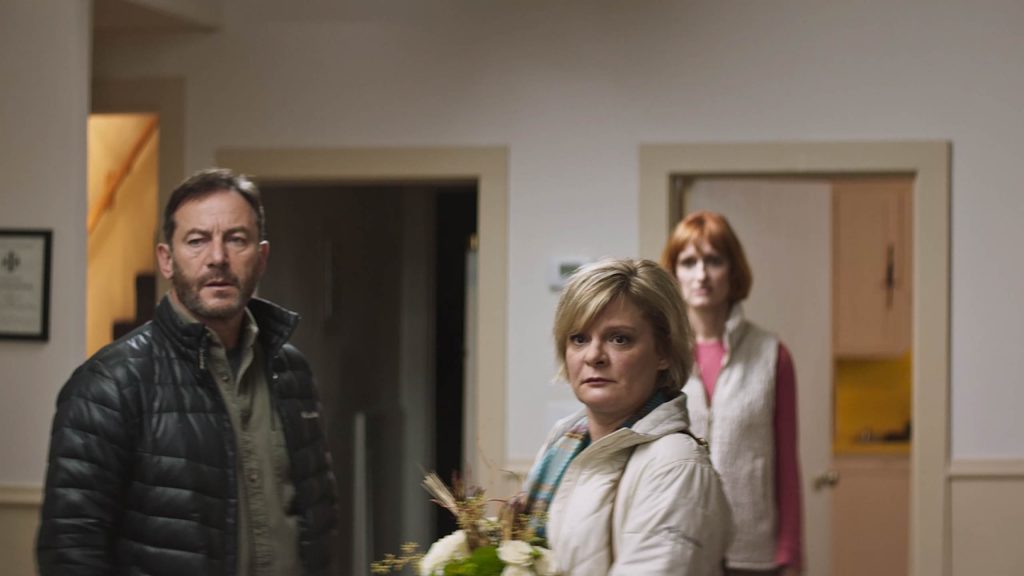April 14, 2022
by Carla Hay

Directed by Rob Schroeder
Culture Representation: Taking place in an unnamed U.S. city, the sci-fi drama film “Ultrasound” features a group of almost all white people (with one African America and one Asian person) representing the working-class and middle-class.
Culture Clash: An unsuspecting man becomes part of a secretive scientific experiment that involves two separate pregnancies by two different women
Culture Audience: “Ultrasound” will appeal primarily to people who are fans of the “Generous Bosom” comic book series and people who enjoy mind-bending sci-fi mysteries.

“Ultrasound” falters with some erratic storytelling, but the cast members’ commendable performances and the movie’s willingness to take chances make it worth watching for people interested in unconventional sci-fi movies. Ultimately, “Ultrasound” is best appreciated by people who don’t mind movies that play tricks on what this story is really about, because the movie’s plot is a mystery that takes its time to reveal its true purpose. Viewers also have to suspend some disbelief when some of the movie’s characters make decisions that are outside the norm of what most people are expected to do.
Directed by Rob Schroeder, “Ultrasound” is based on Conor Stechschulte’s “Generous Bosom” comic book series, which Stechschulte adapted into the “Ultrasound” screenplay. “Ultrasound,” which is Schroeder’s feature-film directorial debut, had its world premiere at the 2021 Tribeca Film Festival in New York City. It’s a movie where a lot of strange things happen that aren’t supposed to make much sense until the final third of the movie where secrets are revealed.
“Ultrasound,” which takes place in an unnamed U.S. city, opens with a scene of a bachelor in his early 40s named Glen (played by Vincent Kartheiser), whose car has broken down in a remote area at night. Glen goes to the nearest house, where a married couple named Arthur “Art” Thomas (played by Bob Stephenson) and Cyndi Thomas (played by Chelsea Lopez) live, so that he can find out where is the closest place to get auto repairs. Glen doesn’t use his phone to get that information.
Upon arriving at Art and Cyndi’s house, Glen meets them for the first time and sees that these two spouses have a very awkward, tension-filled dynamic between them. Art is very talkative and extremely friendly, while Cyndi is quiet and withdrawn. Art tells Glen that the nearest auto repair shop is currently closed. Glen tells Art that Glen has AAA insurance, but Art says that AAA will just tow Glen’s car to Pickton, a city that is 30 miles away. Pickton is also where the nearest motel is, according to Art.
Art is so open and inviting to this total stranger, he immediately offers a room in the house as a place for Glen to stay for the night. Art doesn’t just offer. He insists that Glen stay overnight at the house. Cyndi tells Glen that Art is on anti-depressant medication because he’s had depression for years. Art cheerfully admits to it and says that he always feels better after taking his medication.
And then, things get weird. Art tells Glen that the room where Glen will be staying is the same room where Cyndi sleeps, and that Glen will have to share the bed with her. Art says that is Glen’s only option if he wants to sleep over at the house. Glen is extremely uncomfortable about it, but he doesn’t want to be rude, so he doesn’t exactly get up and leave, which is what a lot of people would do. Apparently, Glen would rather not sleep in his car for the night.
Instead, Glen stays in the room with Cyndi, and they both strike up a conversation that starts off awkwardly. Slowly but surely, it becomes apparent why Glen wasn’t completely opposed to this bedroom arrangement: He’s attracted to Cyndi, who’s a little bit flirtatious with him. In continuing her pattern of divulging too much information to a stranger, Cyndi tells Glen that she’s unhappily married to Art.
Cyndi also mentions that the couple’s big age difference (Art is about 15 to 20 years older than Cyndi) is one of the reasons why their marriage has become unbearable to her. Art and Cyndi met when she was 17, and Art used to be one of her high school teachers. Art and Cyndi got married when she was 19. Cyndi tells Glen that she says she now regrets marrying Art.
Cyndi sadly mentions that if she could go back in time, she would tell her younger self before marrying Art: “What the fuck are you doing, throwing your life away, you fucking moron!” Cyndi adds, “But there’s an energy when people throw away things that people think are important … When you’re done, that energy drains out of you.”
Now that Cyndi has essentially announced to Glen that she’s a lonely and needy wife, the stage has been set for Glen to decide if he’s going to act on his attraction to Cyndi and have sex with her. This sexual one-night stand seems to be something that Art and Cyndi are expecting will happen. At first, Glen thinks that Art and Cyndi are a swinger couple, and it’s a setup so that Art can watch Glen have sex with Cyndi. When he asks Cyndi about it, she denies that Art will be watching whatever happens between her and Glen.
Cyndi and Glen end up having sex, but it’s not shown in the movie. The next time that viewers see Glen, he’s at his home (where he lives alone), and his car has long since been repaired. He found out that the car broke down because it had flat tires that were punctured by what objects that appeared to be nails. And then something unexpected happens to Glen: He gets an unannounced visit from Art.
Glen is so caught off-guard by seeing Art, he refuses to let Art in the house. Glen is suspicious because he doesn’t know how Art got his home address. Art is vague and won’t say how he found out where Glen lives, but Art insists on coming into the house because he tells Glen that he has something important to show Glen. Eventually, Glen lets Art into his home because he can see that Art won’t go away until Art gets what he wants from this unwelcome visit.
Inside the house, Art shows Glen a video on Art’s phone of a baby ultrasound. Art tells Glen that Cyndi is pregnant, and that this ultrasound is of the baby growing inside of Cyndi. And then, Art drops a bombshell: He says that Glen is the father of this baby. At first Glen denies it, but Art says that Glen is the only person who could be the father because Glen is the only man who had sex with Cyndi in the time period where the baby was conceived. Art says that he and Cyndi are willing to do DNA tests to prove Glen’s paternity.
After Glen gets the news that he’s going to be a father, he reconnects with Cyndi, who seems very happy about the pregnancy. Glen tells Cyndi that he wants to be involved with raising this child, even though Glen still feels mistrust and resentment (mostly toward Art) because Glen thinks he was “tricked” into getting Cyndi pregnant. He should’ve thought of that before he had unprotected sex with a stranger.
Meanwhile, another pregnancy issue is shown in “Ultrasound.” Katie (played by Rainey Qualley) is the pregnant, younger mistress of a married politician named Alex Harris (played by Chris Gartin), who is currently up for re-election for an unnamed political office. Katie and Alex’s affair and the pregnancy are both secrets.
Alex has paid for Katie to move to the city where he lives, but he’s been mostly ignoring her. Alex insists that Katie not venture out much from the apartment that he’s renting for her. This semi-confinement is starting to make Katie feel restless and disrespected. “Ultrasound” has a series of phone calls and encounters between Katie and Alex to show what happens in their relationship.
The rest of “Ultrasound” has a lot of spoiler information, but it’s enough to say that Glen and Cyndi end up in a mysterious scientific research lab, where they are forced to undergo experiments and interrogations. Glen is also injured and has to use a wheelchair. The leader of this “research study” is a determined scientist named Dr. Conners (played by Tunde Adebimpe), who is adamant that all of his subordinates follow his rules.
In this “research study,” the two female subordinates who work the most with Dr. Conners are named Shannon (played by Breeda Wool) and Julie (played by Porter Duong), who have very different approaches to their job. Julie is very obedient and never questions what Dr. Conners has to say. Shannon, who does a lot of the research interviews of Glen and Chelsea, has her doubts about the ethics of this “research study,” and she sometimes openly defies Dr. Conners’ orders.
“Ultrasound” takes viewers down a proverbial rabbit hole, where the story has some twists and turns—some of which are more unpredictable than others. Schroeder’s direction maintains a tense level of viewer anticipation and curiosity to see what will happen next. However, enough bizarre things happen where confused viewers of “Ultrasound” might not want to stick around until the end of the movie to find out what it all means.
All of the cast members are convincing in their performances, but Kartheiser and Wool stand out because their characters are the ones who say and do the things that are the most interesting. Glen and Shannon have aspects of their personalities that show they’re independent-minded and are willing to ask questions if things around them start to look suspicious. The ending of “Ultrasound” is a bit jumbled and messy, but it least answers a lot of questions about what these characters have experienced and what might happen to them next.
Magnet Releasing released “Ultrasound” in select U.S. cinemas, on digital and VOD on March 11, 2022.


